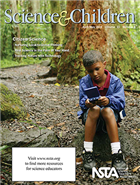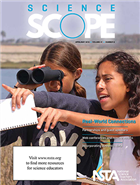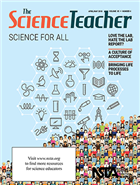Ideas and inspiration from NSTA’s April 2018 K-12 journals
By Mary Bigelow
Posted on 2018-04-17
Regardless of what grade level or subject are you teach, as you skim through the article titles, you may find ideas for lessons that would be interesting for your students or the inspiration to adapt/create your own.
For example, there are definite overlaps between the lesson ideas in Citizen Science and Real-World Connections. Many citizen science projects are appropriate for both elementary and secondary classrooms.
And take a look at NSTA’s online journal Connected Science Learning for more real-world and citizen science projects.
 Science & Children – Citizen Science
Science & Children – Citizen Science
Editor’s Note: Citizen Science “Citizen science opportunities provide real-life experiences that link what students are doing in school to what is happening in the world. They can feel a part of the effort to increase our knowledge about topics that impact their lives. This can be rigorous science reflecting what scientists do while also building solid disciplinary core ideas in the sciences…Students feel empowered with the ability to make a difference through citizen science projects and as a teacher you will likely to feel empowered as well.”
The lessons described in the articles have a chart showing connections with the NGSS and many include classroom materials, illustrations of student work, and photographs of students at work. They also include contact information on the Citizen Science projects used in the lessons.
- In addition to describing their community water quality project, the authors of Water Warriors note that “place-based environmental education and citizen science clearly work in conjunction to strengthen each other. The mix of student engagement and content mastery, while working with community partners, produces experiences that impact students’ lives for years to come.”
- Formative Assessment Probes: Uncovering Students’ Ideas About Watersheds would be a way to assess students’ prior knowledge before starting a water-quality project.
- Real Science in the Palm of Your Hand provides a framework to help teachers use citizen science resources for meaningful science learning in the three NGSS dimensions. (Take a look at a student project, too)
- Fourth graders mentor first graders through a project in Tracking Nature With Technology. The students participated in a bioblitz to study the diversity of the schoolyard using technology to record and send observations and photographs.
- Nurturing Local-to-Global Thinking demonstrates a multi-disciplinary activity in which third-graders combined environmental science, geography, reading, technology, and data analysis in comparing local and faraway places.
- Given A Global Perspective, students collect local soil samples as they share their own data, ask questions, and analyze data from different parts of the world.
- The Early Years: Introducing Children to Phenology has suggestions for experiences in which younger students make observations and collect data about their environment using cameras, drawings, and simple arithmetic. (Phenology–the scientific practice of observing and collecting information on the timing of life cycle changes in plants and animals)
- In addition to recommending trade books, Teaching Through Trade Books: Beneath Our Feet has two lessons (Engineering a City K-2) and Sketching the Sea Floor (3-5) that help students understand how changes on Earth occur over time and how humans have an impact on Earth systems.
These monthly columns continue to provide background knowledge and classroom ideas:
- Science 101: How Does a Thermos “Know” to Keep Hot Liquids Hot and Cold Liquids Cold?
- Science 102: Frozen Coke
- The Poetry of Science: Science Is Us!
- Methods and Strategies: Reading With a Purpose
- Engineering Encounters: The Giant Problem: Using design thinking to explore thermal conductivity
- Teaching Teachers: Learning From Failure
For more on the content that provides a context for projects and strategies described in this issue, see the SciLinks topics Biodiversity, Buoyancy, Conduction Convection and Radiation, Dynamic Earth, Heat and Temperature, Insects, Ocean Floor, Polar Climates, Soil, Soil and Climate, Water Erosion, Water Quality, Watersheds
Continue reading for Science Scope and The Science Teacher
 Science Scope – Real-World Connections
Science Scope – Real-World Connections
From the Editor’s Desk: Real-World Connections for Your Student Scientists Partnerships with scientists, real and virtual field trips, citizen science projects can make science students into student scientists. “Go beyond the typical lab and involve your students in collecting authentic data both in your own community and from all parts of the globe… Give students opportunities to be scientists and they will learn problem-solving skills, practice teamwork skills, and think outside the box. They will begin to make meaning out of their world and better understand nature, their bodies, and the universe.
Articles in this issue that describe lessons include a helpful sidebar (“At a Glance”) documenting the big idea, essential pre-knowledge, time, and cost; many follow a 5E format. The lessons also include connections with the NGSS, and many include examples of student work, assessments, and classroom materials.
- Citizen Science: Prepare an Ant Picnic for Science illustrates a real-world scenario as students explore the food preferences of ants and compare their data with that of citizen scientist around the world.
- Partnerships between scientists and student-scientists are the focus of two articles–Engineering Partnerships makes the connections between science and engineering in a study of deep-ocean hydrothermal vents. The Evolution of a Partnership shows a collaboration to use ongoing research to clarify evolutionary concepts. “Not all science takes place in a lab…sometimes scientists can sue naturally occurring ‘experiments’ to study how evolution takes place.” These articles have suggestions for finding research partners for your student-scientists.
- Bridging the Gap Between “Rocks for Jocks” and the Mars Sample Return Program has a 5E lesson to apply mineral identification process to rock samples from Mars.
- A field trip becomes An Ecosystem Experience, as student scientists apply math, modeling, and sampling to collect authentic data.
- Classic Lessons 2.0: What kind of person becomes a scientist?
- Disequilibrium: Inseparable Magazines describes a 5E lesson on friction using a discrepant event.
- Three articles this month have teacher suggestions for planning, implementing, and follow-up for guest speakers in the classroom: Science For All: Be Our Guest!, Listserv Roundup: Guest Speakers and Mentors for Career Exploration in the Science Classroom and Integrating Technology: Web Conferencing for Student Engagement
- Teacher To Teacher: Using Models to Explain Their Thinking suggests ways to overcome misconceptions students have about models and modeling in science.
These monthly columns continue to provide background knowledge and classroom ideas:
- Scope on the Skies: Gaining Insight Into Mars
- Teachers’s Toolkit: Communicate Effectively With Parents and Family Members Through a STEM Newsletter
For more on the content that provides a context for projects and strategies described in this issue, see the SciLinks topics Careers in Science, Ecosystems, Electron Microscope, Food Chains, Friction, Hydrothermal Vents, Identifying Minerals, Inner Planets, Insects, Migration, Photosynthesis, Predator/Prey
 The Science Teacher – Science for All
The Science Teacher – Science for All
Every April, this is the theme for The Science Teacher. As noted in the Editor’s Corner: Science for All these issues “have been providing teaching ideas and strategies to narrow the academic achievement gaps associated with ethnicity, socioeconomic status, gender, physical disabilities, limited English-language proficiency, and learning differences…The current issue adds to this literature with suggestions for engaging reluctant writers and tactics for creating a classroom culture that values LGBTQ youth.”
The lessons described in the articles include connections with the NGSS (including DCIs) and many include classroom resources and illustrations of student work.
- A Culture of Acceptance has suggestions for classroom management and language that includes LGBTQ students.
- Love the Lab, Hate the Lab Report? describes an alternative to traditional lab reports: an intervention lab report that includes mini-posters and presentations (similar to what we see at conferences!). The article has strategies to get all students participating.
- Bringing Life Processes to Life, especially for English Language Learners, is a challenge. The author provides examples of how to use models for topics such as DNA replication, transcription, translation, and other processes. Photographs illustrate the models, which can be helpful for all students.
- Students assume the role of regional planners as they investigate ways of Using the Land, looking at the pros and cons of development in terms of runoff, habitats, and environmental impact.
- Understanding Earthquakes integrates Model-Based Inquiry into a challenging study of earthquakes and related processes.
- Focus on Physics: The Slowing of Light in Glass includes a novel graphic model to help students understand a complex concept.
- Idea Bank: The Protein Résumé illustrates how to get students to create new ways to present information, rather than copy/paste from the Internet.
These monthly columns continue to provide background knowledge and classroom ideas:
For more on the content that provides a context for projects and strategies described in this issue, see the SciLinks topics Biomedical Engineer, DNA Replication, Earthquakes, Energy Transfer, Environmental Decision-Making, Land Use, Plate Tectonics, Proteins, Transfer of Sound and Light Energy, Transcription, Translation, Tsunamis
Disclaimer: The views expressed in this blog post are those of the author(s) and do not necessarily reflect the official position of the National Science Teaching Association (NSTA).


